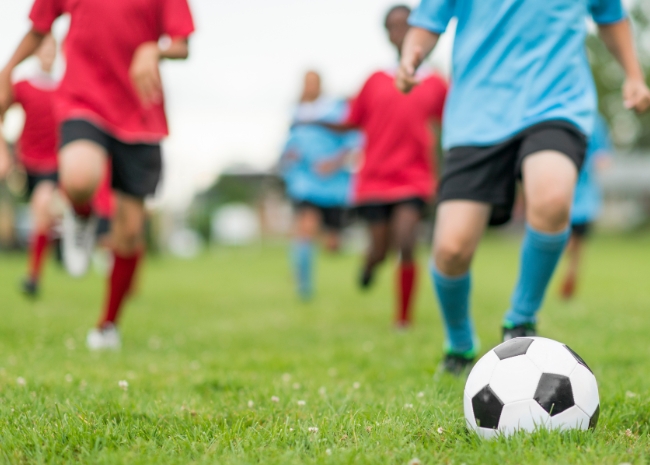
Did You Know? The Reality of Youth Sports Injuries
Did you know that over 60 million children and adolescents participate in youth sports in the United States each year? From soccer to gymnastics, basketball to swimming, millions of young athletes are enjoying the physical, social, and emotional benefits of being active.
Aside from the obvious physical benefits—like improved strength, endurance, and coordination—children who participate in team sports often experience:
- Higher self-esteem: Being part of a team can help kids feel valued and capable.
- Improved school and academic performance: Discipline, focus, and time management learned in sports often carry over to the classroom.
- Less stress and better moods: Exercise releases endorphins, which naturally improve mood and reduce anxiety.
But here’s the thing—participating in youth sports isn’t risk-free. While the benefits are undeniable, young athletes are also susceptible to injuries. In fact, studies show that 90% of student-athletes report some sort of sports-related injury during their athletic careers, and about 2.6 million young athletes are treated in U.S. Emergency Rooms each year.
Understanding these risks—and how to prevent injuries—can make a huge difference in keeping young athletes safe and enjoying their sports for years to come.
Understanding Youth Sports Injuries
Sports injuries in children and adolescents can be broken down into three main categories.
Acute Injuries
Acute injuries occur as a result of a single, identifiable event, usually within the last five days. These injuries often happen suddenly and can be quite painful.
Common examples include:
- Fractures: Broken bones caused by impact or fall.
- Sprains: Ligament injuries that result from twisting or overstretching.
- Strains: Muscle or tendon injuries caused by overstretching or tearing.
Acute injuries are often the most obvious and sometimes require urgent medical attention.
Overuse Injuries
Overuse injuries develop gradually over time and are often harder to detect. These injuries are particularly common in youth athletes who specialize in a single sport and skip rest periods or off-seasons.
Examples include:
- Shin splints: Pain along the front of the lower leg due to repetitive stress.
- Runner’s or jumper’s knee: Inflammation of the knee caused by repetitive jumping or running.
- Tennis elbow: Pain on the outside of the elbow from repeated arm movements.
Interestingly, overuse injuries—sometimes called “burnout injuries”—make up about 50% of all youth sports injuries. This highlights the importance of variety and rest in athletic training for kids.
Chronic Injuries
Chronic injuries refer to pain or dysfunction lasting for three months or more. These injuries often result from repeated stress or unresolved acute injuries.
Examples include:
- Back pain from improper posture or repetitive strain
- Hip pain due to overuse in running or jumping sports
- Knee pain from misalignment or repetitive impact
Chronic injuries can affect not only performance but also a child’s overall quality of life.
Different Types of Sports Injuries
While categorizing injuries by duration is helpful, it’s also important to understand the type of injury.
Sprains
A sprain occurs when a ligament—the tissue connecting bones—gets stretched or torn. Common sprains include ankle and wrist sprains, which often happen during sudden twists, falls, or awkward landings. Symptoms include swelling, bruising, and limited range of motion.
Strains
A strain, often called a “pull,” occurs when a muscle or tendon is overstretched or torn. Hamstrings, calves, and the back are common areas for strains in youth athletes. Strains can range from mild discomfort to severe pain that prevents activity.
Contusions
A contusion is better known as a bruise. It happens when a direct impact causes localized bleeding under the skin or in the tissue. While typically not serious, severe contusions can sometimes cause more damage, like deep tissue injury.
Tears
Tears are the complete separation of tissue fibers, often affecting ligaments, tendons, or muscles. A common example in sports is an ACL tear in the knee, which usually requires surgery and a lengthy recovery period.
Common Causes of Youth Sports Injuries
Injuries in young athletes often occur due to:
- Improper training techniques: Overtraining, skipping warm-ups, or poor form.
- Anatomic or biomechanical issues: Flat feet, uneven leg length, or muscle imbalances.
- Catastrophic events: Collisions, falls, or accidents during games or practice.
Recognizing these causes can help coaches, parents, and athletes take preventive measures to reduce the risk of injury.
Preventing Youth Sports Injuries
The good news? Many sports injuries are preventable. Combining smart training with intentional recovery is key.
Recommended Strategies
The American Academy of Pediatrics offers some clear guidelines for safe youth sports participation:
- Take at least one full month off from a sport 2-3 times per year: This helps prevent burnout and overuse injuries.
- Take 1-2 days off from training each week: Regular rest is crucial for growing bodies.
- Limit hours of participation based on age: For example, a 12-year-old should participate in no more than 12 hours per week.
- Participate in a variety of sports: Delaying single-sport specialization until late adolescence helps develop balanced muscle groups and reduces overuse injuries.
The Importance of Off-Season and Cross-Training
Cross-training and off-season periods allow muscles and joints to recover while still keeping kids active. Encouraging children to play different sports can prevent repetitive stress injuries, improve overall athletic ability, and keep the experience fun rather than overwhelming.
Working With a Physical Therapist
If a young athlete does get injured, working with a physical therapist can make a world of difference.
Physical therapists help by:
- Assessing the injury and its root causes
- Designing a safe, progressive rehabilitation plan
- Teaching proper mechanics to prevent re-injury
- Guiding the athlete back to full participation safely
Early intervention is critical. The sooner an injury is addressed, the faster a child can recover, and the lower the risk of long-term problems or re-injury.
When to Seek Help
Parents and coaches should be vigilant for warning signs that require medical attention, such as:
- Severe or persistent pain
- Swelling, bruising, or deformity
- Inability to move a joint normally
- Recurring injuries in the same area
If you notice any of these signs—or if your young athlete simply isn’t feeling right—don’t wait. Early treatment not only speeds recovery but also prevents future complications.
![]()
Final Thoughts
Youth sports provide incredible benefits for children and adolescents, from physical fitness to mental resilience and social growth. However, injuries are a real and common part of the experience.
By understanding the types of injuries, implementing smart prevention strategies, and seeking professional care when needed, young athletes can stay healthy and continue to enjoy the sports they love.
Remember: rest, variety, proper training, and early care are the keys to keeping kids safe on the field.
If your child is experiencing pain, or you know a young athlete dealing with injuries, reach out to a healthcare professional or physical therapist. The faster you act, the sooner they can get back to the game—and have fun doing it.
The Jackson Clinics serves 18 locations throughout Northern Virginia.
Find one near you: thejacksonclinics.com/locations
















